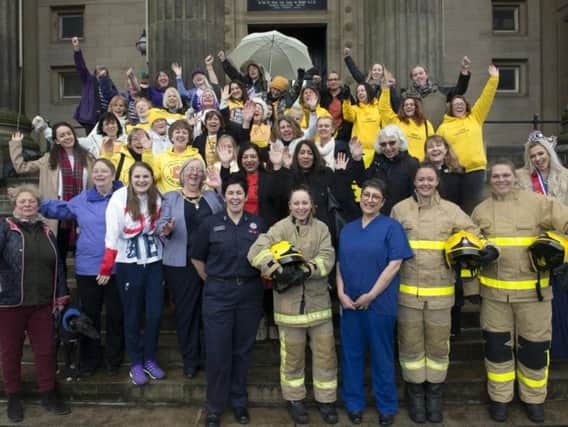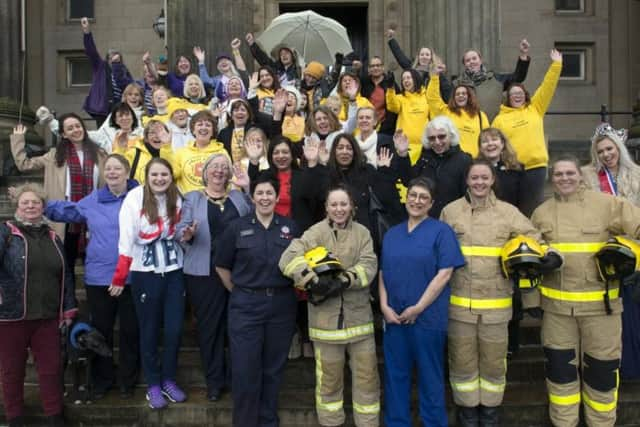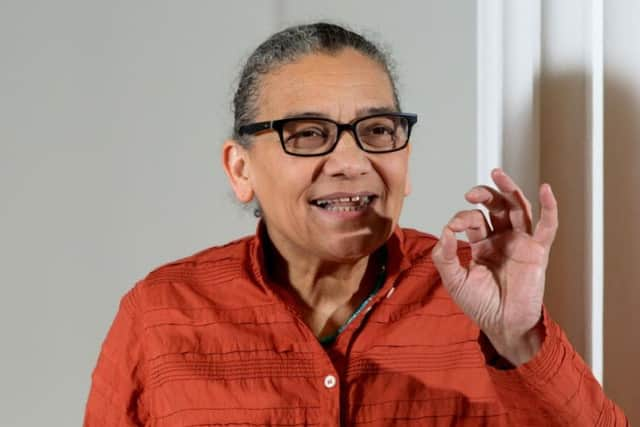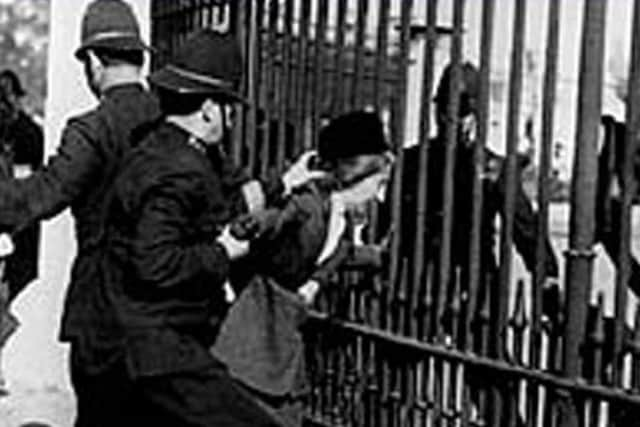100 years on: Celebrating today's suffragettes in Lancashire


Although far from the end of the struggle, February 6 1918 marked a huge milestone - and the culmination of decades of passionate and sometimes violent campaigning.
Over the next five weeks the Lancashire Post will celebrate the fighting spirit of the remarkable women who became suffragettes and show how their courage continues to inspire the women of Lancashire to break down barriers.
Advertisement
Hide AdAdvertisement
Hide AdOur Today’s Suffragettes series has brought together some of the most incredible women in Lancashire today and will give a voice to these amazing, inspirational, diverse, passionate and pioneering women who continue to break down barriers across the social spectrum.


From the woman who fought a six-year legal battle to allow her to take part in the sport of boxing to one of the first women to be ordained as vicars, via the young BAE engineer touring schools to get girls more interested in taking up science, we see how far women have come in the last 100 years. We also examine the battles that still need to be fought today, from the gender pay gap to sexual harassment in the workplace.
Today, we sit down for an exclusive interview with Preston artist Lubaina Himid MBE whose pioneering work saw her become the first black woman and oldest person to win the coveted Turner Prize.
Lubaina Himid - ‘There are actual real inequalities...’
In winning the 2017 Turner Prize, Preston-based artist Lubaina Himid MBE has blazed a trail for other female black artists.


Advertisement
Hide AdAdvertisement
Hide AdBut this is not just by virtue of being the first black woman to have won the much-coveted award.
Throughout her career Lubaina has always curated exhibitions to showcase underrepresented black artists.
Her artwork is also about making black and female lives visible and she has achieved this in more ways than one.
She said of the aftermath of the prize: “A lot of young artists have contacted me saying they can see that it can be done, that I have made things look possible.


Advertisement
Hide AdAdvertisement
Hide Ad“I’m not sure that that is so but they feel it and half of the time if you feel it so then you can come up with ways of making it so.”
Since winning the £40,000 prize, she has an even wider platform from which to share her work and to exhibit artwork from other, up-and-coming black women artists.
In Naming the Money 2014, 100 cut-out life size figures show black servants and labourers, each of which has an identity - a name and a story.
Swallow Hard: the Lancaster Dinner Service, 2007 shows crockery painted with the faces of people who were enslaved during Britain’s colonial history.


Advertisement
Hide AdAdvertisement
Hide AdOn challenging institutionalised invisibility through her work Lubaina said: “It’s the leaving out and the erasing from the history that I am interested in.
“It’s about looking at the system or look at this history. There are actual real inequalities that I can see out there.
“I’m sure that people from West Africa or people from the Caribbean were contributing to this city but they don’t seem to be represented or written here, for example.
“If one thinks about enslaved people in the same way that one thinks about their own family you think of them as actual human beings but when people talk about slaves it’s as if they were just like lions or tigers, but of course everyone of those people who was on those ships had a name.
Advertisement
Hide AdAdvertisement
Hide Ad“Those people were part of a community, part of a family, had names, thought about a future and then were scooped up and made to be no better than animals.
“Lots of the work is about trying to say ‘don’t erase people’s histories, don’t lump people together as asylum seekers’, people have actual names.”


And for Lubaina, as well as recognising the individuals and their stories in a group of people she feels that with diversity, the more there is to celebrate.
“I think as one set of people become more visible and their contribution to the bigger picture is acknowledged then you see well actually the bigger picture is actually enriched by the many different components,” she said.
Advertisement
Hide AdAdvertisement
Hide Ad“It makes it a more collaborative and hopeful thing to think that lots of people together made a change.”
As an artist, an advocate and a curator Lubaina has always celebrated the role of black artists and their contributions to contemporary society.
Right from when she was working towards her masters at the Royal College of Art in London she was travelling round the country seeking out other young black artists. Her interest had been piqued by what they were doing.
“I wanted to know what the black artists were making and why,” she said. “I would find artists and then put on an exhibition so over the years I got to know a lot of people.
Advertisement
Hide AdAdvertisement
Hide Ad“I held the exhibitions with work from different artists because I’ve never wanted to be the only person doing it.
“I don’t agree with the thing of the lone genius and also it’s quite difficult to make artwork and show art unless you know other artists and are talking to other artists.
“Lots of my friends are artists and they’re making work that is being shown in international galleries but nobody would know that this is going on.”
Because of that Lubaina is keen that the wake of her Turner Prize win will help to propel other black women forward as well.
Advertisement
Hide AdAdvertisement
Hide Ad“I think its given some people more confidence. I think its given some people writing about us or putting on shows more confidence that there is work of quality out there.”
But Lubaina is also keen to be seen as artists, not pigeon-holed into certain brackets such as black artists or as female or old artists.
Lubaina said: “You do this thing where you can get some visibility if you can call yourself a black woman artist but then of course you then have to deal with always being boxed in that way.
“A lot of us are making very different work from each other which was the point of my showing it altogether saying, ‘yeah these could name themselves as black women artists but some are making big installation sculptures and some are making tiny films’.
Advertisement
Hide AdAdvertisement
Hide AdAlthough she was the first female black artist to win the Turner Prize and the oldest at that, she feels that she just thinks of herself as herself.
“Of course I just think of me as me,” she said, about when her name was announced as the winner. “The evening was a bit of blur - I heard my name and
I had to keep making sure in my mind that that was my name that I’d heard.
“My cousin had to say ‘get up and go.’”
Lubaina will be holding an exhibition of her artwork at the The Harris Museum and Art Gallery in Preston from March 2 until June 3. The opening night is on March 1.
Advertisement
Hide AdAdvertisement
Hide AdEdith Rigby - at the forefront of the fight for women’s rights
One woman at the forefront of the fight for women’s rights was the Preston-born suffragette Edith Rigby.
The social reformer founded St Peter’s School in Preston in 1899, which allowed girls to meet and continue education beyond the age of 11.
However she is perhaps best known for setting fire to soap powder magnate Lord Leverhulme’s holiday home in Rivington, near Chorley, and was one of the first women in Preston to ride a bike.
Advertisement
Hide AdAdvertisement
Hide AdEdith also made the headlines after throwing a black pudding at an MP, planting a bomb at Liverpool Cotton Exchange, joining the Pankhurst sisters’ hunger strikes and window breaking campaigns and protesting at a 1909 Preston meeting addressed by Winston Churchill.She was born in 1872, the second of seven children, to surgeon Alexander Rayner.
Just before her 21st birthday Edith married doctor Charles Rigby, moving to Winckley Square in Preston.
There she was determined to become involved in working for social reform, initially improving the lives of women and girls in local mills.
She joined the Independent Labour Party in 1905, a year later forming a branch of the Women’s Labour League in Preston.
Advertisement
Hide AdAdvertisement
Hide AdIn early 1907, Edith formed Preston’s branch of militant suffragette organisation, the Women’s Social and Political Union.
Edith’s home on Winckley Square can be seen along the Blue Plaque Heritage Walk.
Her story is now also the focus of a play, Woman on Fire, which has already made it to the Edinburgh Fringe Festival.
The Preston-based theatre company which has produced the show, Certain Curtain Theatre Company, is now gearing up to take the production on tour in April.
Advertisement
Hide AdAdvertisement
Hide AdClaire Moore, who directed the play and who also plays Edith, said: “We wanted to celebrate an unsung suffragette and she had a fantastic character.
“The violence that the women experienced in the protests and the force-feeding of women in prisons was hard to deal with.
“Edith was a very persuasive woman and I quite liked that about her. People were engaged with her on a personal level. She did a massive amount for children and working girls but she was spat on and vilified by the people that she lived with in Winckley Square.”
Who were the suffragettes?
In 1832 the Great Reform Act extended the vote to a proportion of the male population – previously only a tiny handful of wealthy landowners could vote.
Advertisement
Hide AdAdvertisement
Hide AdThe Act, followed by further bills in 1867 and 1884 meant that the majority of British men could vote in General Elections.
But women remained totally excluded from the ballot, and from any representation in parliament.
There had been previous calls for an increase in voting rights, but in 1903 the campaign picked up a gear with the formation of the Women’s Social and Political Union.
Founded in Manchester by Emmeline Pankhurst and her daughters Christabel and Sylvia, it took a more direct, confrontational approach.
Advertisement
Hide AdAdvertisement
Hide AdTheir tactics included marches, demonstrations, vandalising empty buildings and arson attacks. As more and more women were arrested for breaching the peace, they developed the tactic of hunger strikes in prison.
Probably the most famous suffragette action was taken by Emily Wilding Davison, who in 1913 threw herself in front of the king’s horse during the Derby.
She was killed and the WSPU made her funeral into a massive rally, with 5,000 mourners following her coffin.
Upon the outbreak of the First World War, the group suspended campaigning and got involved in the war effort, although many individual members were pacifists and did not take part in war work.
Advertisement
Hide AdAdvertisement
Hide AdWomen - at least those over the age of 30 – were finally granted the vote in 1918, and in 1928 the franchise was finally made equal for men and women.
Suffragette Spirit by comedian Shappi Khorsandi
The struggle to win the vote was long and arduous, but in 1918 brave suffragettes up and down the country won.
Since then, women around the world have channelled the suffragette spirit to campaign for progress. They have stood up to racism, sexism, homophobia, corruption and much more.
Last century’s suffragettes are today’s women human rights defenders. Every day they harness their passionate voices to empower communities and create a fairer world.
Advertisement
Hide AdAdvertisement
Hide AdAmnesty International campaigns to help protect women human rights defenders around the world. These brave campaigners often face surveillance, intimidation, threats, imprisonment and some even risk their lives. But you don’t need to travel thousands of miles to meet women fighting for justice and equality. In fact, there’s probably a woman human rights defender living at your doorstep. This is why Amnesty and the Lancashire Post want readers to nominate the incredible women who are making a real difference in their local area. Ordinary women from all walks of life – from students to shopkeepers, office workers to OAPs – are doing extraordinary things. They might have stood up to bullies, helped the homeless, aided refugees, worked to protect the environment or campaigned for better access to healthcare. The list goes on.
Every time these women have spoken up, they’ve helped make life better for others - to ensure that you and I, as well future generations, enjoy a fairer, more equal world.
The amazing achievements of these often-unsung heroes deserve to be celebrated, and Amnesty wants to put them on its Suffragette Spirit Map of Britain.
The interactive map, which will launch on International Women’s day, will be a symbol of the suffragette legacy – proudly displaying how far we have come over the past century, but highlighting how much life-changing work is still being carried out today. So, over to you: Which 21st century suffragette deserves to be put firmly on the map?
How to nominate'‹
Advertisement
Hide AdAdvertisement
Hide AdTo nominate an amazing woman your local area, email [email protected] and visit www.amnesty.org.uk/suffragettespirit. All women must have carried out work to help others their local area within the last 10 years. All successful nominees will be contacted to give consent prior to being placed on the Suffragette Spirit Map of Britain. This campaign has been funded by People’s Postcode Lottery.